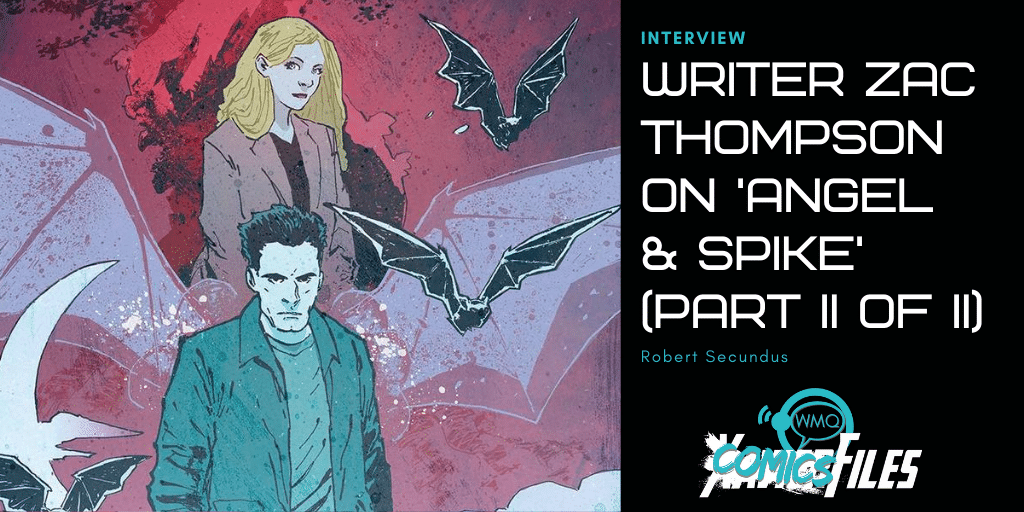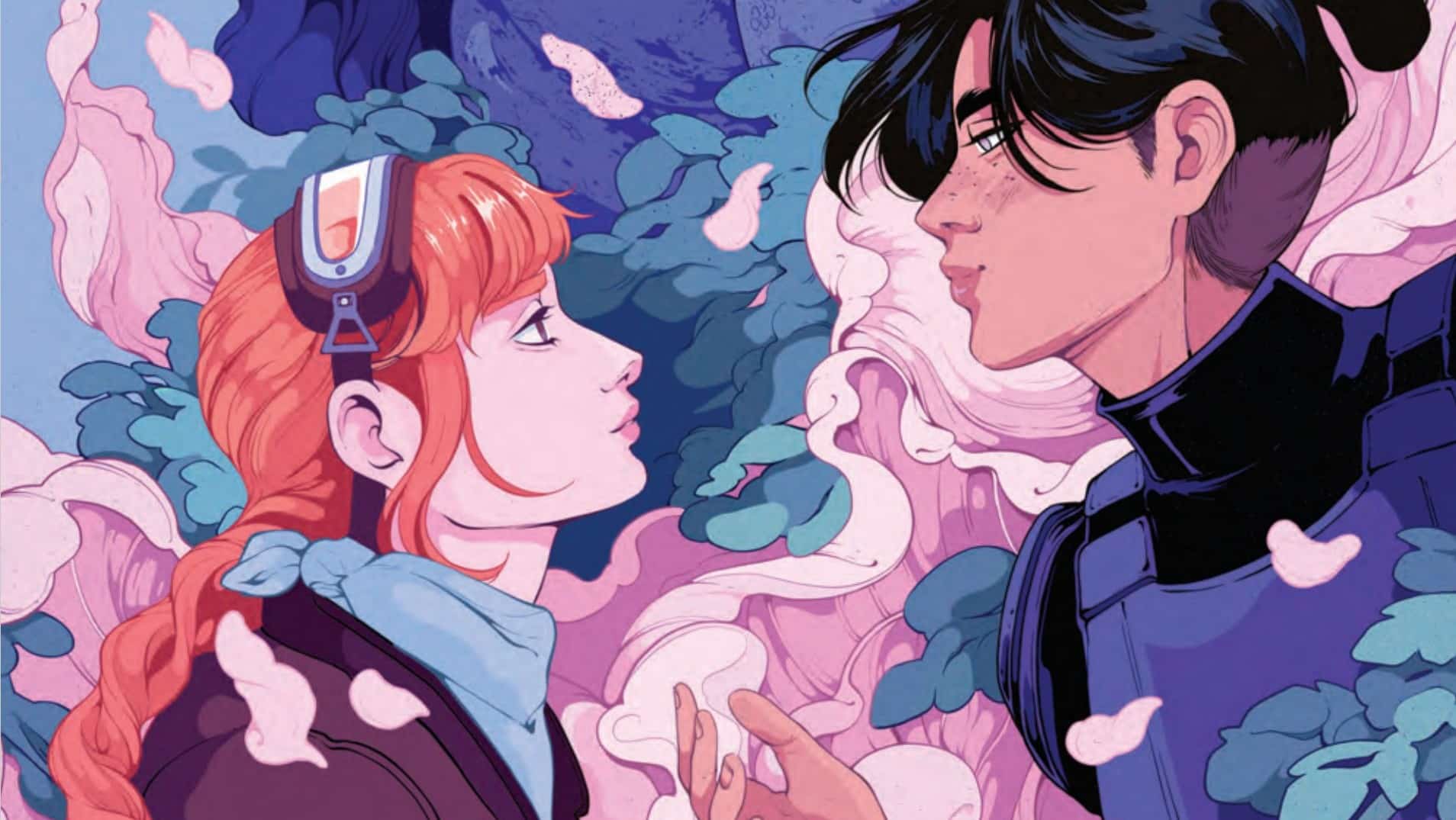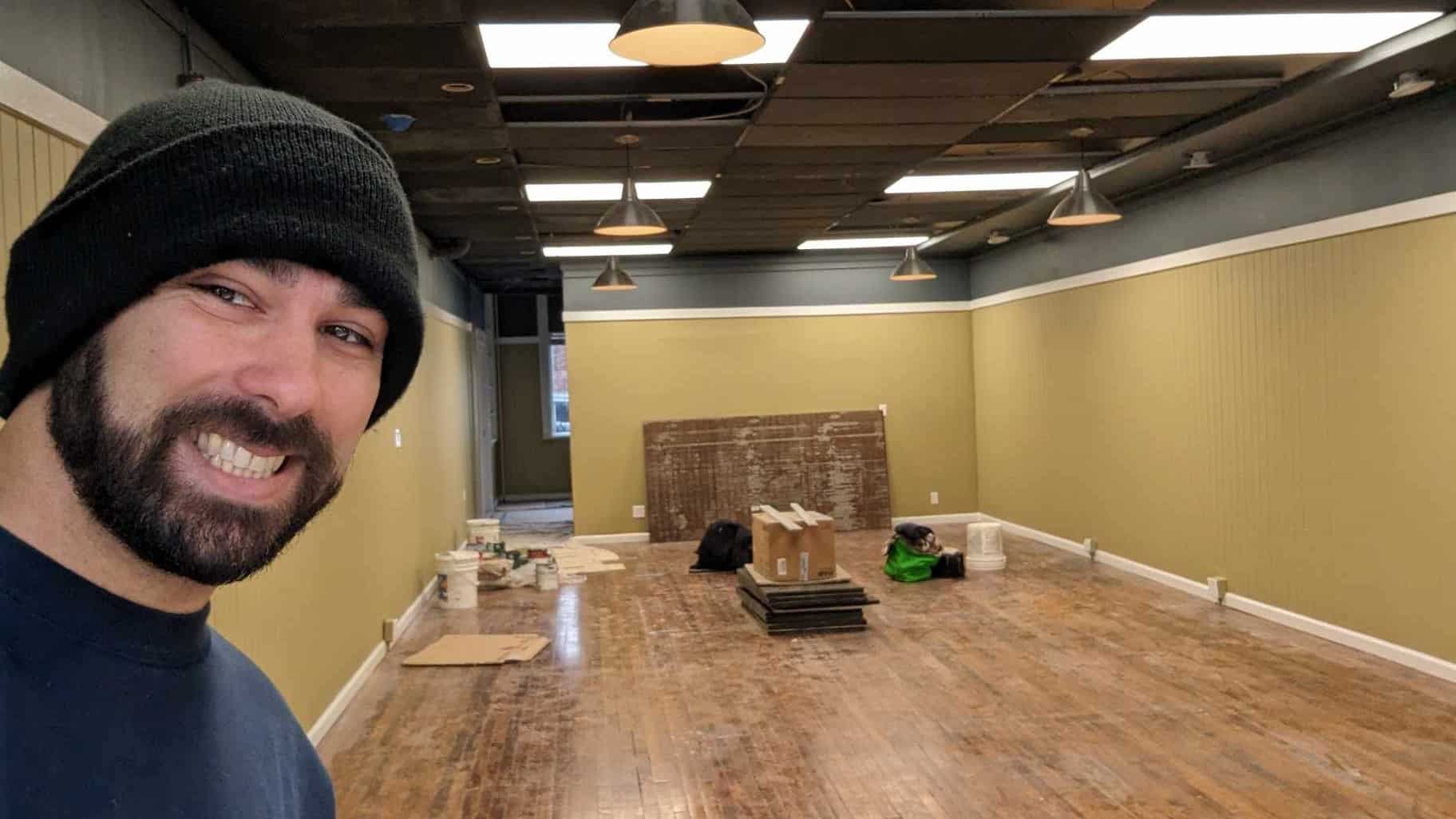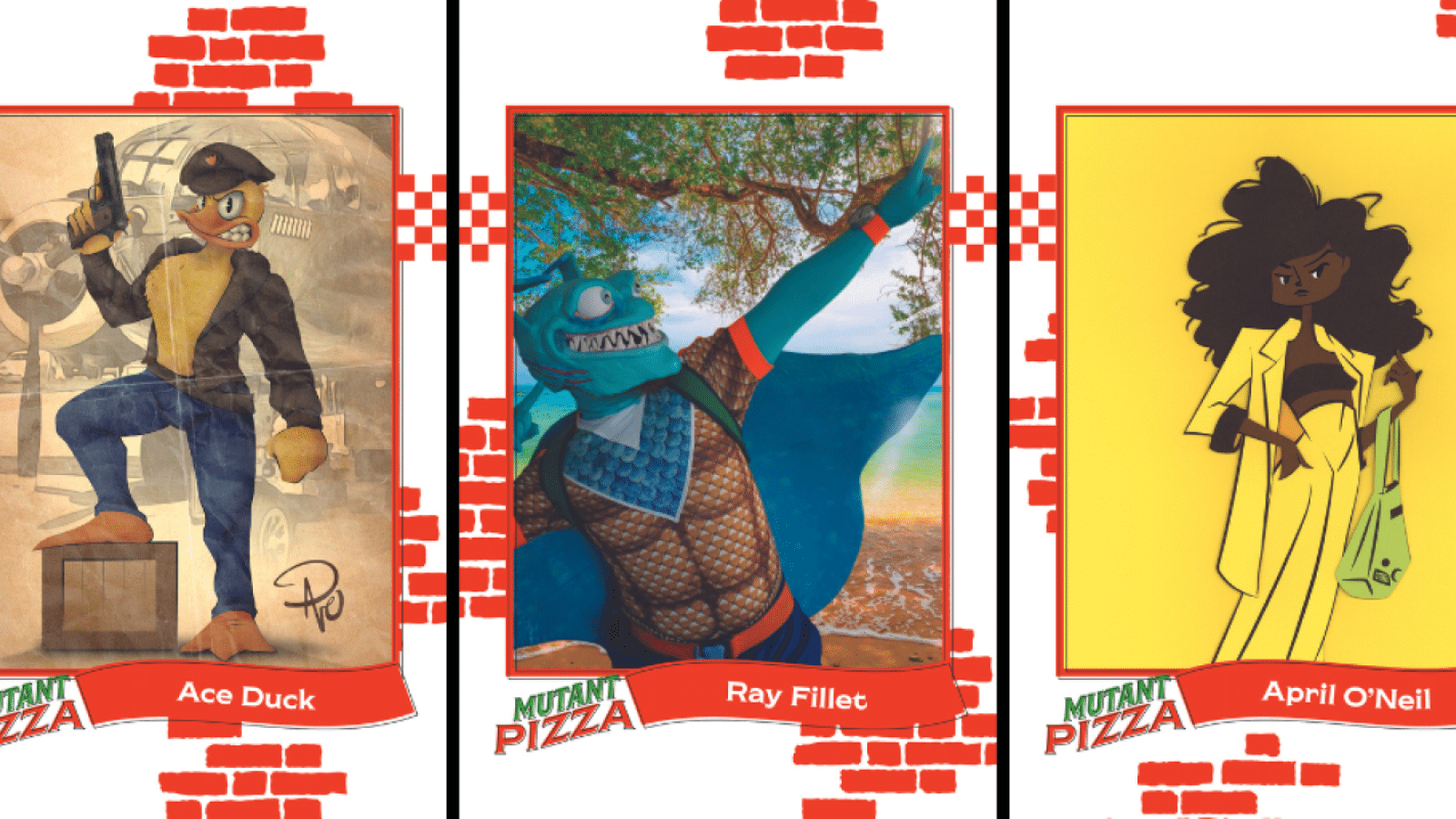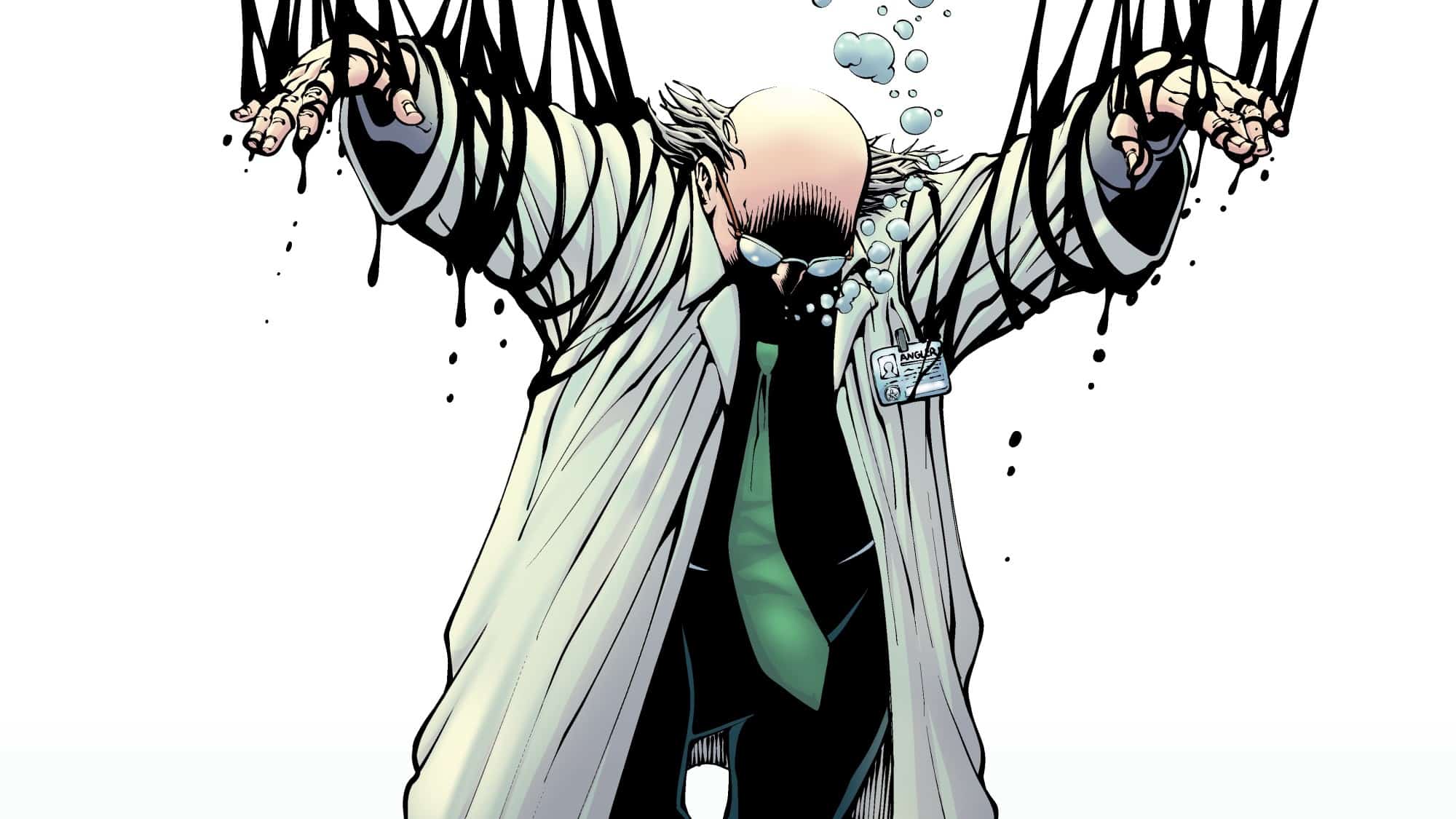Bryan Edward Hill and Gleb Melnikov revitalized and reimagined Angel for a new age in Angel & Spike. This September, Zac Thompson and Hayden Sherman are continuing that reimagination, starting Sept. 23 in Angel & Spike #14, and hoping to create stories in the BOOM!-fyverse that both capture the magic of the original series and critically reevaluate the source material.
This interview took place July 30. It has been edited for length and clarity. Content Warning: Contains a discussion of suicide and suicidal ideation in fiction as well as representations of sexual violence.

RS: I think if you’re ready, we can talk about “Unleashed,” Season Five, Episode Three of Angel, which I had not seen in many years and really surprised me.
ZT: Yeah, I picked it for a variety of reasons.
RS: About two-thirds of the way through, something happened that made me go, “Oh, yeah, this seems a very Zac Thompson episode!”
So for people who do not remember “Unleashed,” Team Angel uses the resources of Wolfram & Hart to track down and protect a newly turned werewolf, Nina Ash. The episode opens with a discussion about the team’s newfound roles at the demonic law firm. So my first question, Zac, given that this is an early Season Five episode: What do you think about that radical status quo change of the season that was so, like, I imagine in the day must have been such a revelatory paradigm shift in television to take a show and go, “Nope, this is radically different now”?
ZT: I am, you know, I’m a huge fan of that kind of thing. I wish more television, or whatever [fiction], took more risks like that. Just because I think it’s such a brilliant sort of inversion. I think at that point in time, Angel was a show that was really struggling to find its own voice. I think Season Three is really interesting because it deals with a lot of Angel’s past; Season Four is like, there’s just so much going on all the time. It’s like, both the best and worst. Very bloated. And then Season Five becomes this leaner, meaner, more refined. I think they finally kind of figured out what their themes were, as a show, and what they were trying to say. And it’s really fascinating to take the Big Bad of the series, and then basically go like, “Now you’re in charge of it.” I would have loved, in 2004, to be a fly on the wall to what fans thought about at the time, because I’m sure people fucking hated it. But it’s aged really well! It took the show and gave it a firm sort of place within the world and said, like, “Hey, you know what? Let’s make some of these themes kind of overt, that they are ostensibly evil and they’re working within evil to stop even bigger evil” — which I think has always been kind of the crux of Angel, but it really took shape there. And I think that you have that corporate aspect that a lot of genre television really doesn’t explore.
And it’s so funny to me because like, you know, writing, Wolfram & Hart, like an evil corporate law firm in 2020? Those pages fly out! They come so quickly because it’s like, I’ve got all this pent-up rage about this kind of stuff. You get these people talking to one another with a smile on their face being like, “The troll division has really sold a lot of seeds of discord today,” and they’re giving each other high-fives, and making like, “Fuck yeah, we spread a QAnon conspiracy theory” or whatever! It’s awful, but it’s a reflection of reality. There are people who celebrate suffering, and that has become more and more evident as this year has trudged forward. And I think that like, there’s a lot of catharsis in taking characters who are essentially superheroes and putting them inside that environment and allowing them to muse on it in a really interesting way. And then on top of that, you get that, like, reflexivity of: These are corporate characters owned by corporations within a law firm. There’s so many levels of subtext to it that I could go on forever, but I love it. I think Season Five is the best season of Angel by a country mile.
RS: Yeah, it feels like one of the better seasons of television period even for — well, I was gonna say even for its limitations of wrapping up too soon, but then also, I don’t know if it would be the same if it had gotten another season with that status quo.
ZT: I love that finale so much, even though watching it hurt me so deeply the first time I saw it. It stuck with me over and over again; It was sort of this idea like, well, if you can put your ending in the audience’s mind and leave your last chapter, or the end of your world, in a place where they can just imagine what comes next, then somehow that’s more satisfying sometimes than being like, “Here’s a clean answer about why everything happened the way it did.”
RS: And just like you’re saying that Season Five is when, even though it’s a radical change, everything comes into clarity — it’s taking what’s already there, and just making it very apparent and very on the screen — the season finale, or even just that last shot of the season finale, is the entire series in a single shot.
ZT: Yeah, exactly. And like I feel like that’s so powerful. I mentioned that on one of my first calls with BOOM, being like, I want to do something like this, like, this is the feeling I want to evoke. And everyone was like, “Fuck yeah! Like we know exactly what you’re trying to talk about.” And there’s also — this is an aside, but Buffy has so much stuff in it that’s really good. You can pull out any episode and be like, “This is what I want to do.” And people are like, “Yep, OK, cool. We’re all down with that.” And everyone has an understanding of what you’re trying to achieve. There’s very few pieces of television or pop culture that you can do that with.
RS: Absolutely, absolutely!
I want to return to what you said earlier about Angel’s reflection of reality. Because in “Unleashed,” we get a werewolf. Now, Buffy, Buffy uses monsters to reflect on high school and high school anxieties. I think, generally, Angel is a lot more complicated. People talk about the anxieties of adulthood. People talk about, again, trying to find some way to exist in this evil world without doing more harm. The monsters are less clear reflections, I find, and so while Oz and the werewolves in Buffy seem oftentimes to be explicitly expressing anxieties of puberty and sexuality and teen romance, I don’t have a great grasp on what Nina’s condition is reflecting here. So what do you think about it?
ZT: I mean, that was part of the reason I chose the episode, because I was like, I think there’s something interesting here, but the execution’s a little bit stumbly. There’s some stuff towards the end of the episode where you kind of find out what’s happening to her that’s fascinating. But her character itself . . . I want to say in that episode, it’s supposed to be like a stand-in — a bad one, but what I understood it to be is a stand-in for sexual violence or something that has happened to you that results in trauma following you, and so you can’t really escape that. And there’s a weird speech that he gives to her at the end where he’s like, “Someday you’ll be in a supermarket with your like,” I think it’s a goddaughter or whatever? And he’s like, “and you’ll realize you’re a werewolf and it won’t matter.” And I was like, OK, I understand sort of the metaphor you’re trying to make. But using a werewolf for a stand-in doesn’t make a lot of sense only because, you know, a werewolf represents unlimited power. It’s this idea that you’re so powerful you cannot be controlled. And so, that’s not exactly what people walk away from things like that with. And so, I saw that as a product of male gaze and a product of the way that that character is treated as sort of being really male gaze-y.
There’s even a scene where she wakes up in a cell and Angel walks in and she’s like, flailing her limp wrists on his chest as he’s like, “Calm down,” and shoves her in and I’m just like, you know — it has its problems. And I guess I had forgotten some of that. And then I started watching Season Five when I got the gig. And that was one of the first episodes I saw. And that was the moment where I was like, “Oh, I have to do so much fucking better than this.” And I have to sort of absorb the good with the bad because there are some interesting themes in that episode.
RS: Absolutely.
ZT: Like her being prepared for food, and people who eat werewolves is a really interesting premise. It’s just the execution of her arc is so sloppy that I was like, OK, I can’t do that. I have to come up with something better. I have to make this metaphor stand for something that is more representative of the reality that we live in. And so for me, we’ll now represent how a certain section of society now feels like it’s comfortable to consume other people without really any sort of repercussions on that group, because of who they are in society or what sort of role they occupy. And so I really wanted to take something like that and bring it into the world of Angel and show there are people who are monsters and who choose to be monsters because it allows them to have power over other people. And there’s something there that you can unpack with Angel in and of himself, with Spike, and some of these other characters who are monsters who have power over other people and occupy, let’s say just for the sake of ease, a privileged state in this world of superheroes and demons, and that they are aware of these other things, and they can fight against people. I really wanted to juxtapose Angel’s role and power dynamics within a city of helpless people with other people who are ostensibly helping others, but for all the wrong reasons. And that’s — sorry, I can’t really get into any more plot details, but you know, that theme of a certain subset of people consuming others was a pretty large part of my first comic, The Dregs. So, you know —
RS: I was going to mention that that was the part where I was like, “Oh!” It’s very much comparable to The Dregs, not just literally the cannibalism, but also thematically. And thematically “Unleashed” feels like a lot of art being produced right now, not just The Dregs but also Hannibal, which you mentioned earlier. Art about the 1% and the elites as beautiful, dapper, classy aristocracy consuming people alive. So, an interesting thing about the real monster of the episode, man, is that like, they win in every way, right? Like, not only do they get to walk away, but Angel gives them a new werewolf to dine on as the episode closes.
ZT: It’s pretty fucked up!
Which is sort of what I like about it. It’s messy. It’s weird. It doesn’t fully track in places, but, for the most part, what I like is that a show in 2004 is trying to buck convention in some interesting ways. And I think that there’s a lot of power in that. I try really hard in my own work to work against convention. Lonnie [Nadler] and I, my often co-writer, talk a lot about like — we wish we could just introduce side characters who have very complicated plots, and they look like they’re gonna play a very intricate role. And then towards the climax, they just DIE! Or like, they just disappear. The idea of, you know, acting against what people think is going to happen by giving them something that’s largely unsatisfying, by saying like, sometimes this happens in life. Sometimes things don’t work out the way you want them to work out. And we, I think, as a society are now consuming pop culture on a level which is insane. We are always trying to make things fit. A theory for why things happen the way they do — I think it’s largely why we’re in this predicament, like, politically in North America, is because we sort of think that something’s gonna all click into place and then everyone’s gonna be like, “Holy shit, he’s a fascist! He’s gotta go!” And it’s like, nah, that’s not gonna happen. I’m sorry. You want a clean conclusion to a very messy problem, and messy problems often have very messy solutions. And that’s the thing that I do like about Angel. Do I think it nailed it on “Unleashed?” No!
RS: I do think for all of its problems, that scene of tossing an evil man to the elites to consume does get at what you were talking about earlier: working within the system in the moment, where you know you can’t overthrow it in that moment. But you do one thing to help someone survive that system.
ZT: Yeah. I think the premise of Angel in and of itself is, how do you combat this as best you can and try to get people out of this system of oppression or whatever it may be, while knowing that the system will continue to consume people. But if you save just one person, it’s better than doing nothing.
RS: Now — I’m trying to think of a way to phrase this question that doesn’t sound like, “Do you think your comic about this vampire can end fascism?” Which is obviously silly. So I want to preface my question by saying I know that that’s ridiculous. But the best way I can think to put question is: Do you think that kind of messiness and hard turn in structure and in plot — do you think, like, when you shock the reader, when you open up these messy areas that don’t fit cleanly — do you see that as an antidote to the kind of numbing art that we constantly consume? If clean-fitting narrative is part of the problem that got us to where we are, then is really messy narrative a possible, partial, incomplete antidote to the problem?
ZT: I think that yes, sort of. I just finished writing my newest series, which is full-on weird fiction. And it slowly mounts there. Weird fiction is sort of predicated on this, like, no easy answers to problems that you’re confronted with. And what that looks like on the outside is that what you’re doing is just crazy. And you’re just throwing a bunch of stuff at the wall. But what it actually is, is a very meticulous construction behind the scenes. So things are revealed slowly to you, in order for you to draw your own conclusions, and hopefully offer you a multitude of conclusions from the story as it reveals itself to you, and says no one sort of takeaway from this very messy situation is more valid than the other. And I think that that’s sort of what I hope to achieve with Angel — bearing in mind that it still has to go through the corporate machine, which is — the irony is not lost on me. It has to go through BOOM. And then it has to go through 20th Century Fox, which is also now owned by Disney. So there’s three levels of checks and balances. And I will say they have been incredibly supportive. And they do not hold the original canon as sacrosanct. It is there. It exists. And there’s nothing I can do in their mind that would dismantle or burn that down because it already has the fandom that it does. So they’ve been very supportive in doing whatever, just sort of exploring wherever you want to go.
So I am hoping that — for all intents and purposes, Angel and Spike is basically a superhero comic. It sits in an equivalent sort of stage: These are very powerful characters, dealing with very ridiculous situations at an accelerated pace, as dictated by the genre that they occupy. Having said all of that, I want it to be still a reflection on that corporate state in a way that is much more messy than things that exist beside it. And that, like, when you’re working in that very volatile space, you can’t get a clean sort of, like “üü rah we did it!” sort of — that was a weird “ooh rah,” you can tell I’m a Canadian [Note: We attempted to transcribe the Canadian “Ooh Rah” as accurately as possible]. Yeah, you can’t really get that sort of clean cut, like we fully all arced, and we all sort of went through a change. Because one, that’s not Angel, and two, that’s not, I think, fair to the world that we live in. And Buffy and Angel have always sort of reflected modernity. It sort of exists around us. It’s very reflective about pop culture, and it name-drops a lot. It makes jokes with things that are going on in the world currently. And that was something I was encouraged to do, is play within the space of 2020. And, you know, if you’re going to do that, and if you’re going to do Angel, then you have to get messy. There’s no other way to do it.
Stephen King’s Cycle of the Werewolf
RS: I have a couple of questions that start with the episode of Angel but expand out to a wider — I guess they’re more really about the kind of horror that Angel and Buffy engage with in general. The first one’s about werewolves because — in my horror reading and watching, I am very ignorant of werewolf stuff writ large. So I asked you for a couple of pieces of werewolf homework. And I found a weird through line between them, between An American Werewolf in London and The Cycle of the Werewolf. And then that link popped up again in “Unleashed,” I think. In both that film and that novel, there’s this explicit call for suicide near the climax, an intense call for suicide. And then when I was watching “Unleashed,” suicide isn’t explicitly mentioned in the episode, but the kind of frame that you talked about, of trauma and PTSD, also seems to me to feature a kind of suicidal ideation, as Nina focuses on cutting ties, on her life being over, and on everything ending. And I’d never expected — it wasn’t the kind of thing I’d expect in werewolf fiction to pop up three times in a row from three fairly random samples. So I feel like there’s something there. And yeah, I’m wondering if you could speak to that. If you see the werewolf as, like, this archetype or this monster involving mental illness or depression or suicidal ideation in any way? Because that really, really surprised me.
ZT: I think that’s a thing because — I’ve been looking at this a lot as well, and I think it’s a thing because it’s a cycle, because you can anticipate it, because it sort of removes you from who you are. You know, depression can work like that, where you know that you’re depressed right now, and you might get out of it, but it’s always sort of lingering in the back of your head: When will I fall into depression again? When will I have to deal with these awful feelings again? And when you’re at your lowest low, you can think, well, it might just be easier to opt out of this whole thing and walk away from all this. Obviously not the solution, it stands to say that, you know, if you’re going through something like this, there’s so much support out there for people, and they should definitely seek it out.
But with werewolves in particular, that was something that I was very surprised to see as well. I think maybe part of it is that there’s that evisceration that happens to you. That full sort of loss of humanity, where you’re completely dehumanized, completely removed from yourself, and unaware or unaccountable for some of your actions. If you go through very deep depression or suffer from mental illness, you can dissociate from reality, you can do things where you wake up two or three days later and have to put the pieces back together, have people fill in the blanks for you. It’s, one, extremely embarrassing; two, it can haunt you; and three, you could wake up with trauma that you will have for the rest of your life. And so, it’s neat to see horror deal with those complicated feelings, especially through a heavy genre lens. That’s the horror that I love the most, horror that really explores primarily human feelings but uses a genre lens or a supernatural lens to play around with it. And I think in particular, being a werewolf is simultaneously an act of creation and an act of destruction, right, that human self is destroyed, and that werewolf self is born. Vampires sort of oscillate on that same level, where there’s that duality at play all the time. That’s what I was really fascinated with, that’s why I wanted to tell that story (it’s not a secret at this point that my first arc deals with werewolves in the book). But I was really fascinated with, like, if I’m going to do a monster-of-the-week, I want to delve into this classic territory.
But I want to look at what that means in 2020, which I think is a very different thing than what werewolves even meant 10 years ago. I read a book a couple years ago called Mongrels by Stephen Graham Jones. He’s a First Nations author. He just released a book called The Only Good Indians that’s supposed to be one of the best horror books of the year. And that sort of looks at what it would be like to be a werewolf almost as a stand-in for being First Nations, where you are part of a clan. And that is part of your identity, like, you’ve known from the moment that you were born that you were an Other. And that sort of sat with me for a really, really long time. That you know, when you carry around depression, or you carry around mental illness, that is your invisible cross to bear. And there’s no sort of social interaction that you’ll have where you won’t think about that for a moment and go, you know, “did I just say something extremely depressing and bring the whole room down?” And I like to think that werewolves are like, “Am I gonna shift and then eat all these people later on tonight?” Yeah, so I don’t know why suicide keeps coming up. But it was also something I thought of a lot, too. And, you know, in particular with one of the characters that I have in my story, there’s a through line where it’s like, the old version of this character has been destroyed, and this new version of this character that you’ve never met before, that is sort of part of my design is being reborn.
RS: So, this my last Angel specific question, related to the previous one. The vampire has gone through a lot as, like, an archetype since Buffy aired. There’s been so much vampire fiction that has poked at and played with the archetype. And I think at this point, people have talked several times about the vampire cycle in and out of pop culture. But it really does seem like the vampire is of the modern era, that the vampire is the one monster that is always present throughout the past century. How do you see the vampire as an archetypal monster in 2020?
ZT: Yeah, I mean, this was on my mind a lot when I took the gig. Because if I was going to be perfectly honest with you, I would never write anything of my own that dealt with vampires. Not because I don’t like them as a concept, but mostly because I do struggle with everything that could be said about them being already said. Now, with that in mind, I just a couple months ago read Octavia Butler’s amazing novel Fledgling, that looks at vampires in a more sort of anthropological way, as like a class of a species of people that evolved differently and have their own, different customs. And, you know, if I was allowed to do whatever I wanted on Angel, that’s something that I would have loved to explore, to get into the lore of vampires and really deal with it in a way that explodes outward and goes into the history of them and their customs and their practices. And, you know, what we see of these vampires here in the modern day Buffyverse is actually sort of an evolution from a different sort of species that existed a long time ago. Mind you, they would never let me do any of that, because that’s rewriting a lot of the lore that already existed.
So for me, I think vampirism has a theme of redemption. A lot of the time, you are this awful being that needs to kill to live and you can’t live within the sun. So you have to exist outside of the world of regular people. That inherently carries a lot of guilt and a lot of musing on your past. And you know, a lot of these characters are very old. And so I really want to just basically go: Is redemption possible? But let’s present both sides of that theme and have a character who is seeking redemption, being Angel, and then a character who doesn’t fucking care, Spike, doesn’t care about redemption, doesn’t have any remorse for anything that they’ve done, but on top of that doesn’t have any direction, and because of those things doesn’t have anything they want. They only want chaos. And what does that do to a person when they don’t have agency, when they’re lost within a world where vampires have become very present? And they’re no longer special? How do you scratch at that?
I wanted to do this classical sort of take on the vampire with Angel, and then a sort of reflexive look at what it means to be a vampire with Spike, and have those two things be in conflict with one another. And that was the way that I felt like I could do something new and interesting with this, especially because these characters are now interacting with one another and each other’s stories far sooner than they were in the actual show. If you puzzle this out, the comic probably takes place around the Angel Season One/Season Two kind of era. They haven’t really gone through the same things. Angel is still struggling to find a purpose for what he’s doing. And like I said before, Spike doesn’t have a soul.
RS: So, to wrap up … let’s say you’re serving Angel #14, or the first arc, as the first course in a meal. What are two pieces of media — fiction, movies, TV show episodes, wood cuttings, paintings, poems, whatever — what are two other things that you would recommend to people as a complimentary dish in that feast? Not necessarily the same sort of thing, but a complementary flavor you’d want to pair it with.
ZT: I think Stephen Graham Jones’ Mongrels would be great. It was the first sort of werewolf book that I read, where I went, Oh, damn, you can do this differently. You can really think about this in a different way. And I’m a huge sucker for anthropological approaches to anything. I like that sort of like, let’s take this very silly thing extremely literally, and unpack it, and look at the DNA of how things like this grow over time. And that’s part of how I approach this. And then because I just recently revisited it, and visually, it is something that Hayden and I are trying to channel quite a bit, is Kathryn Bigelow’s Near Dark. A sort of Western vampire movie from I think the late ’80s, maybe early ’90s, with Bill Paxton playing what ended up almost being an exact replica of Cassidy from Preacher?
RS: Oh, wow.
ZT: The sunglasses, the blood down the mouth, like there’s a shot in the movie where I’m like, I am positive this is the inspiration for Cassidy. I could be wrong, but it feels too close.
RS: Well, that is something that I will be adding to my list to watch immediately.
ZT: Hell yeah!
Angel & Spike #14 is available Sept. 23 at your local comic shop and on comiXology.
Robert Secundus is an amateur-angelologist-for-hire.

